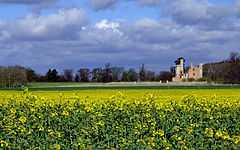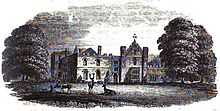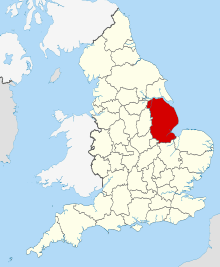Haverholme Priory
| Haverholme | |
 Ruins of Haverholme Priory |
|
 Haverholme |
|
| OS grid reference | TF107494 |
|---|---|
| – London | 100 mi (160 km) S |
| Civil parish | Ewerby and Evedon |
| District | North Kesteven |
| Shire county | Lincolnshire |
| Region | East Midlands |
| Country | England |
| Sovereign state | United Kingdom |
| Post town | Sleaford |
| Postcode district | NG34 |
| Police | Lincolnshire |
| Fire | Lincolnshire |
| Ambulance | East Midlands |
| EU Parliament | East Midlands |
| UK Parliament | Sleaford and North Hykeham |
|
|
Coordinates: 53°01′51″N 0°20′57″W / 53.030800°N 0.34930122°W
Haverholme Priory was a monastery in Lincolnshire, England. Its remains are situated 4 miles (6 km) north-east from the town of Sleaford and less than 1 mile (1.6 km) south-west from the village of Anwick.[1]
Foundation
Gilbert of Sempringham founded the only English order of the Cistercian monks, who were given Haverholme Priory, by Alexander, Bishop of Lincoln, located between the villages of Anwick and Ewerby in Lincolnshire. The Cistercians later sold the monastery to Gilbert.
Gilbertine operation

The Gilbertines also inherited the responsibility for keeping the neighbouring fens drained, and to maintain a foot ferry to Sleaford across the River Slea at Ewerby Waith. They were however summoned to account in 1316 when it fell into disrepair. They were summoned again in 1360 when Alice Everingham, daughter of John de Everingham, who was supposed to have taken vows, fled from the Priory, only to be hunted down and recaptured. She complained to the Bishop of the time that she had never taken vows and she was being held against her will, so he ordered her to be released.
It is rumoured that Thomas Becket hid there during one of his arguments with the King.
Dissolution and subsequent history
Henry VIII dissolved the Priory and it had various owners for the next two and a half centuries. It was bought by the Finch-Hatton family. George Finch-Hatton, 10th Earl of Winchilsea and 5th Earl of Nottingham rebuilt it in 1830. It was used as a family home by the Finch-Hatton family for almost a century but by the early 1920s it was up for sale.[2][3] Haverholme was sold in 1926 to an American woman who had most of it dismantled, stone by stone, to be rebuilt in America. The cargo was on the dock in Liverpool when the buyer became a victim in a train crash. Eventually the stones, never shipped to America, were used to build new docks.[4]
One casualty of this was the Sleaford Canal locks, which also fell into disuse, effectively closing the canal.
The present ruin is the remains of a Gothic building built around 1835 by H.E. Kendall, itself a rebuild of an earlier house dating from 1780, and now a Grade II listed building and designated Ancient Monument.
References
- ↑ Historic England. "Haverholme Priory (351056 )". PastScape. Retrieved 12 November 2014.
- ↑ The Estate Market: Haverholme Priory: Sporting Property. The Times, 19 August 1921, p. 15, col. G (first paragraph).
- ↑ "Haverholme Priory". The Times, 31 August 1921, p. 18, columns A and B.
- ↑ "Denys Finch Hatton's Boyhood Home", karenblixen.com
External links
- Map sources for Haverholme Priory
- Historic England. "Details from image database (192569 )". Images of England.
- Nottingham University Library, Department of Manuscripts and Special Collections, records of Haverholme Priory

